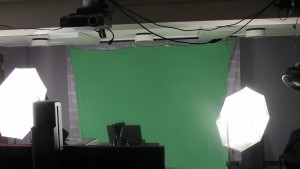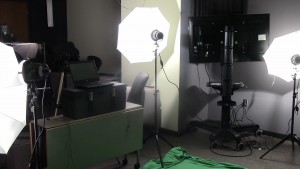In the latest installment of “how-to” (or at least “think about this”) posts about filming your own mini lectures, I discuss the wonderful world of green screens. We have all seen this. Every weather reporter stares at a green (or sometimes blue) screen while using off-camera monitors as guidance. That big weather map behind her: there is nothing there except a blank green screen. This presents those of us making videos with a wonderful opportunity to project an image or images onto a background and then layer live footage or text on top. But there are some things you need to consider before using a green screen. Continue reading
Tag: technology
So, if you have been following the blog you now have had a glimpse behind the scenes and read about why I initiated this project. Hopefully you have watched a few of our videos by now. If you haven’t, please do so before reading this blog post.
Welcome back. So, you watched a few videos and thought, “Wow! How did they do that.” Ok, perhaps you said, “Meh…” but are still interested in our process. Aleks and I will walk you through a video from start to finish. We really had no fancy equipment; only what we could get at our media center on campus. You’ll see in the images that we worked in about half of a small room that served as our studio and then edited in a old closet.
What kind of experience did we have coming into this project? Karl has conducted some oral histories and edited in iMovie (he hates Apple products, but iMovie is far superior to Windows Movie Maker). During the year Aleks works at the Clarke Forum for Contemporary Issues where she regularly uses software such as PhotoShop, InDesign, iMovie, and Audacity to create visuals and edit interviews. Because Aleks knew more of the editing tech than Karl, in most cases we divided the labor. Karl came up with ideas and wrote scripts; Aleks filmed and edited it all. There are some exceptions which we will discuss at a later time.
First thing you should know: Continue reading
I don’t know if there is a rule about how dormant a blog can become before it is impossible to revive it, so I am going to do it anyway!
Ok, so it has been two years and six since Teaching History last posted (I feel like I’m in a confessional!). Yeah, life intervened. But it is back, and I have an exciting last half of the year lined up. Rather than finishing my book, I have been working with one of my students to shoot short videos (mini-lectures of a type) for some of my classes. In the coming months we will be blogging about the process, pros and cons, how to posts, and including data on student feedback surveys.
So, stay tuned, tell your friends, and send me comments when we get started. One of our first posts will be on student-faculty collaboration, so please check it out.
Well, it has been some time since my Willoughby training at Dickinson on how to use various technologies more effectively in the classroom. Not all topics, like 3D printing, were relevant for the courses I teach, but I learned about more methods and media than I can possibly wrap my head around at this point. For now, I am integrating just a few items, primarily in my First-year seminar on utopias, so that I can extend my learning curve over a number of semesters and begin to see how the technologies effect learning and the workload for professor and students.
The easiest of the technologies to introduce is the blog. When teaching in London a few years ago I used the blog extensively as a way to extend the conversation beyond the classroom. At first the dialogue did not happen organically. But through some repetition, instruction, and prompts, the quality of the posts and comments dramatically improved. Students learned how to write texts (and I view the blog primarily as a way to teaching writing and critical thinking in a new medium), post still and moving images, embed walking tours of the city with Google Earth, and more. In my current First-year seminar we are learning the basics of posting, tagging, and commenting. This weekend the students will have their first audio blog, in which they use Audacity to produce a podcast, which they then post with some minimal text to the blog.
We will also be working with video projects near the end of term. Students will practice with iMovie and Audacity to produce a multi-media final project. For their training session, they will use still and moving images from an upcoming field trip to Eastern State Penitentiary to produce a video blog. I think it is important that students have an introduction to these technologies, but my chief intention is to strengthen writing and thinking. For a video project, one has to master more than the technology. Storyboarding teaches students to organize their thoughts, think about what is most critical to their story, and imagine their audience. Without thoughtful content and a connection with the audience, we simply have visual candy. That is not the point of these exercises. By using digital media, I hope to get students to practice serious writing (their scripts) more and thereby improve their writing in general. The assignments also have students improving research and analytical skills.
I’ll let you know how the projects turn out and give you an update at the end of the semester about the time commitment for students and for me.
How do you use technology in your courses? Russian history is an easy venue for using Google Earth and maps, Twitter, blogs, and GIS. I’m hoping to use the latter in my Soviet history course next semester. If any readers have used GIS in their classrooms, please let us know.
 Courtesy Llewi034 at en.wikibooks
Courtesy Llewi034 at en.wikibooks
This week I am participating in Dickinson College’s Willoughby Fellows program. From 8:30 to 4:30 each day this week the ten fellows meet with our academic technology staff to discuss a host of technologies that we can use as teachers, but also that we can introduce to our students as tools to enhance their learning as users of these technologies. Over the course of the week I will be sharing a few of the bits that I have learned that I hope to use in future teaching not only in my Russian history courses, but also in other courses. Please stay tuned and give me your thoughts and provide our readers with examples of your use of technology in the classroom.
Today we are covering Delicious, Twitter, Google+, blogs, and beginning our discussion of digital storytelling. All in one day!!! I’ll let you know my first impressions.


